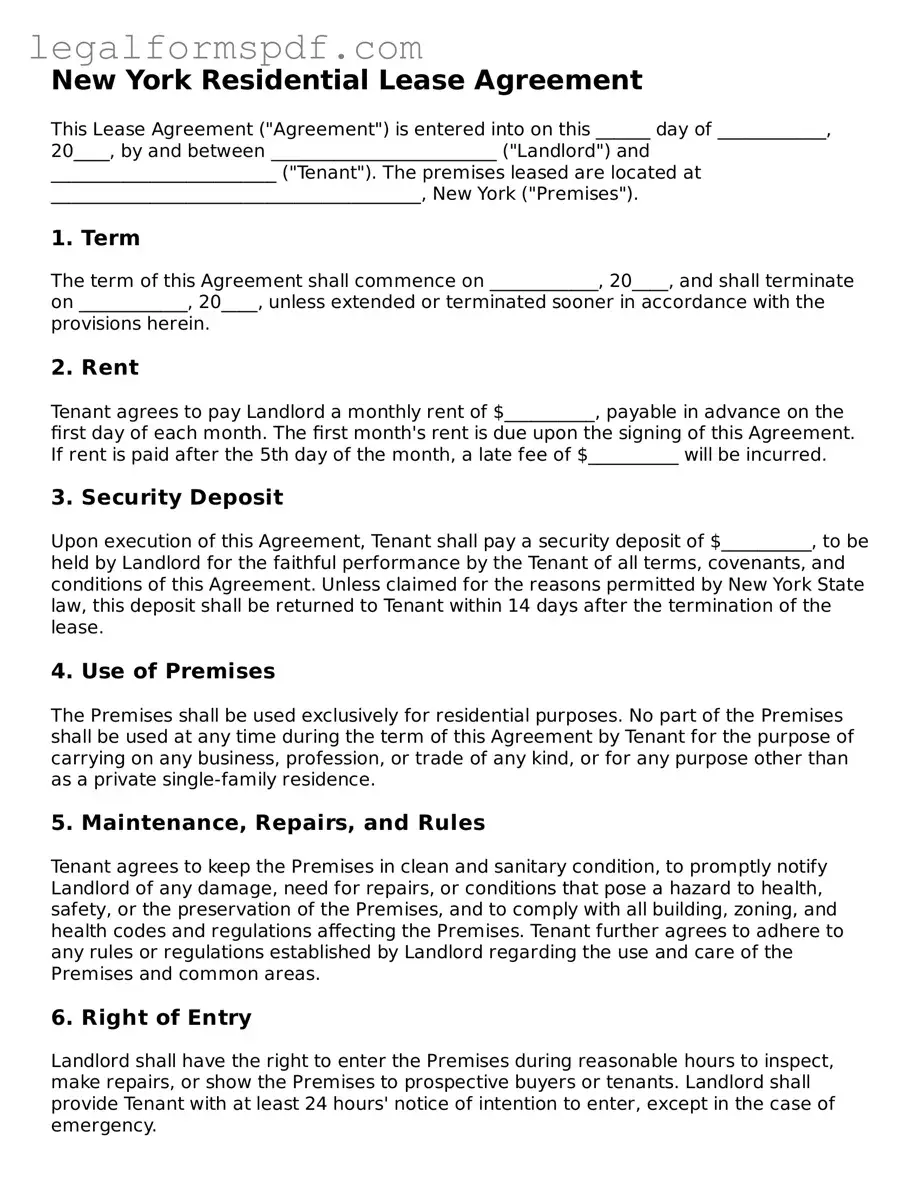New York Residential Lease Agreement
This Lease Agreement ("Agreement") is entered into on this ______ day of ____________, 20____, by and between _________________________ ("Landlord") and _________________________ ("Tenant"). The premises leased are located at _________________________________________, New York ("Premises").
1. Term
The term of this Agreement shall commence on ____________, 20____, and shall terminate on ____________, 20____, unless extended or terminated sooner in accordance with the provisions herein.
2. Rent
Tenant agrees to pay Landlord a monthly rent of $__________, payable in advance on the first day of each month. The first month's rent is due upon the signing of this Agreement. If rent is paid after the 5th day of the month, a late fee of $__________ will be incurred.
3. Security Deposit
Upon execution of this Agreement, Tenant shall pay a security deposit of $__________, to be held by Landlord for the faithful performance by the Tenant of all terms, covenants, and conditions of this Agreement. Unless claimed for the reasons permitted by New York State law, this deposit shall be returned to Tenant within 14 days after the termination of the lease.
4. Use of Premises
The Premises shall be used exclusively for residential purposes. No part of the Premises shall be used at any time during the term of this Agreement by Tenant for the purpose of carrying on any business, profession, or trade of any kind, or for any purpose other than as a private single-family residence.
5. Maintenance, Repairs, and Rules
Tenant agrees to keep the Premises in clean and sanitary condition, to promptly notify Landlord of any damage, need for repairs, or conditions that pose a hazard to health, safety, or the preservation of the Premises, and to comply with all building, zoning, and health codes and regulations affecting the Premises. Tenant further agrees to adhere to any rules or regulations established by Landlord regarding the use and care of the Premises and common areas.
6. Right of Entry
Landlord shall have the right to enter the Premises during reasonable hours to inspect, make repairs, or show the Premises to prospective buyers or tenants. Landlord shall provide Tenant with at least 24 hours' notice of intention to enter, except in the case of emergency.
7. Alterations and Improvements
Tenant shall make no alterations or improvements to the Premises without the prior written consent of Landlord. Any authorized alterations or improvements shall become the property of Landlord upon termination of this Agreement.
8. Governing Law
This Agreement shall be governed by and construed in accordance with the laws of the State of New York. Any disputes arising under or related to this Agreement shall be resolved through mediation or, if necessary, in a court of competent jurisdiction within the State of New York.
9. Entire Agreement
This Agreement constitutes the entire agreement between the parties and supersedes all prior discussions, agreements, or representations, whether oral or written. No amendment to this Agreement shall be effective unless in writing and signed by both parties.
Signatures
By their signatures below, the parties agree to the terms and conditions of this New York Residential Lease Agreement.
Landlord Signature: _____________________________ Date: ____________
Tenant Signature: ______________________________ Date: ____________
